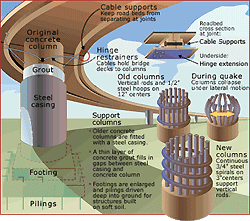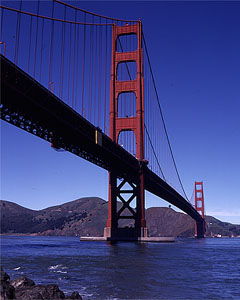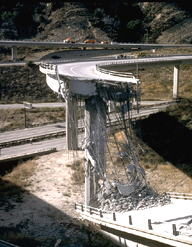
|
||||||||||||||||
|
|
|
Fixin' for the Future Los Angeles is a mythically expansive tangle of freeways passing over and under each other. In 1994, the Northridge quake lurched the earth beneath the city, twisting the aging overpasses. Some of them absorbed the shock. Others collapsed, killing drivers and cutting residents off from vital thoroughfares. What made the difference? Some of the older freeway bridges had already undergone retrofitting, the process of adding features to a structure to strengthen it against the forces of earthquakes. In this case, the California Department of Transportation had begun dressing the support columns of existing bridges in a dapper jacket of thick steel that kept them standing during the quake. All the overpasses that failed during the quake were still awaiting their retrofit. Older overpasses are supported by vertical steel rods embedded in the concrete of the pillars holding up the highway. If these rods are bent by the pressure of the freeway rocking above them, they lose their strength and continue to bend outward. Ultimately, the pillar can collapse. The steel girders prevent these rods from bending too far outward, helping the pillar retain enough strength to support the freeway above it. Along with adding steel girders, engineers can add size and weight to a bridge’s footings, and anchor the footings more securely into the ground. Thick cables hold sections of the freeway together and secure it to the support pillars. One of world’s most famous spans, the Golden Gate Bridge, poses a bit more of a retrofit challenge. It’s not just the magnitude 8 threats posed by the nearby San Andreas and Hayward faults that make the job tricky. The entire 2 miles (3 km) of bridge, much of it over water, is being strengthened without interrupting the flow of cars, bicycles, and pedestrians admiring the view it offers. The work is happening in several phases, over at least five years. When it's done, the structure should be strong enough to withstand a magnitude 8.3 quake, with hefty foundations, approaches resting on base isolators, and roadbeds linked together to flex as one fluid piece. The freeway collapses during the Loma Prieta and Northridge earthquakes prompted a massive retrofitting effort in California that is still under way. When it’s complete, over 2100 spans will have been strengthened. |
Live Eye • Great Shakes • Quake Basics • Damage Control • Active Zone




